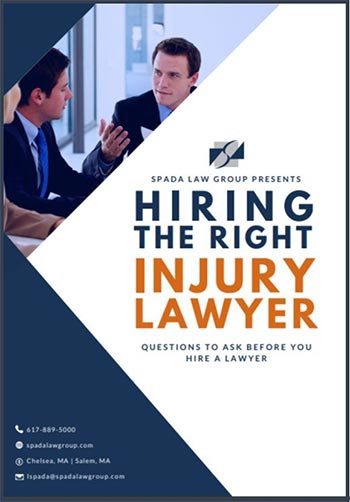 Everyone who rides a motorcycle knows there is just something special about the experience - it’s not just about getting from one place to another, it's also about enjoying how you get there. Maybe you’re not even going anywhere and are riding just for the joy of riding.
Everyone who rides a motorcycle knows there is just something special about the experience - it’s not just about getting from one place to another, it's also about enjoying how you get there. Maybe you’re not even going anywhere and are riding just for the joy of riding.
Something tricky about being a motorcycle rider in Massachusetts is that when you’re riding, your safety depends both on you as a rider but also on the realities of traffic and the other drivers around you.
This blog will provide you with a few safety checklists to go over before you hop on your bike for a ride. Because you can’t control the other drivers on the road, and because motorcycle riders are so vulnerable in a collision, you need to do everything within your control to reduce your risk of an accident.
Unfortunately, the United States Department of Transportation (DOT) reports that motorcycle riders are more likely than car passengers to die if involved in a traffic accident, so you need to take extra steps to be safe. It’s just a fact of riding; bikers face more risks on the road than people in cars and trucks.
Massachusetts State Motorcycle Laws for Permits & Licenses
First and foremost, to be able to legally operate a motorcycle in Massachusetts, you need to have a Massachusetts motorcycle license.
State law requires anyone who wants to operate a motorcycle to have a MA motorcycle (class M) driver’s license. Before applying for a motorcycle license, you first need to get a learner’s permit. To get a learner’s permit, you need to be 16 years old or older, complete an application, pay a fee, have a valid ID, and pass a knowledge test.
Motorcycle permit restrictions in Massachusetts
- You can only operate a motorcycle during daylight hours
- You cannot carry passengers when you ride a motorcycle
- You cannot get a motorcycle license without either passing the requisite road test or successfully completing the Massachusetts Rider Education Program
How to get a Massachusetts Motorcycle License
Massachusetts state law allows anyone who fulfills all the motorcycle permit requirements, who is over the age of 16.5 years old, to apply for a motorcycle license (as long as their right to a driver's license or right to operate a motor vehicle hasn’t been revoked).
Massachusetts Motorcycle Riding Checklist: How to Prepare for a Safe Ride
How you prepare to ride a motorcycle helps determine the safety and enjoyment of your ride. Getting ready to ride a motorcycle includes making sure you have your license, are wearing and bringing the proper equipment, you’ve checked over your bike, and you have mental clarity and remember defensive driving strategies for safety.
Massachusetts Motorcycle Riding Checklist: Your Gear and Proper Equipment
Wearing the proper equipment goes a long way to protect you when you’re riding your bike. Quality gear that fits can reduce the risk of injury and proper helmets, protective clothing and face and eye protection can help protect you in the event of a crash or accident. The idea is to dress for your ride and any potential hazards you may encounter, including a crash.
The more highly visible your gear is, the better. Bright colored clothing will help other people on the road see you better than if you wear dark colors. If you plan to ride at night, you can buy reflective clothing and also add reflective strips to your helmet and back of your boots.
-
Helmet:
- In Massachusetts, both motorcycle riders and passengers are required to wear a helmet so there’s no skipping this step. According to the National Highway Traffic Safety Administration (NHTSA), a helmet is able to prevent a brain injury two-thirds of the time if you’re involved in any type of accident.
- Make sure your helmet is DOT compliant, this means it meets certain safety standards.
-
Jacket and Pants:
- Wear a jacket and pants to completely cover your arms and legs. Leather, denim and other study synthetic materials will help prevent scratches, abrasions and help protect you from the elements or stray rocks tires from other vehicles might send your way. Some riders even choose to get rigid body armor inserts for additional protection.
-
Boots and Shoes
- When you ride, your boots or shoes should cover your ankles and be sturdy (so we’re not talking about your Chuck Taylors). The soles of your shoes should be hard, durable and slip-resistant. Shorter heels are better so they don’t catch when you ride over rough terrain. Another tip is to tuck your laces in so they don’t catch on your bike anywhere.
-
Gloves
- Gloves help you to grip better and protect your hands in an accident. They’ll also protect your hands from anything that might fly up to hit your fingers while riding. Gloves are recommended to be leather or a durable synthetic material.
-
Additional Recommendations: Eye Protection and Rain Gear
- Eye protection: It doesn’t take much to injure your eyes, so we recommend a high-quality visor on your helmet, goggles, or shatterproof glass. A windshield on your bike won’t protect your eyes from dust, sand or even glass.
- Rain Gear: A quality rain suit designed for motorcyclists will resist ballooning at high speeds and tearing apart, and will help keep you comfortable and safe in the event of a storm.
Massachusetts Motorcycle Riding Checklist: For Your Bike
Did you know Massachusetts law actually requires motorcycles to meet minimum safety equipment standards? As a motorcycle rider, you need to ensure that all safety equipment on your bike is in good working condition. This includes your horn, rearview mirrors, mufflers, lights, brakes and fenders.
Make sure you know your bike and have read your bike’s owner's manual. Your motorcycle’s manual will have information such as the correct tire pressure, chain adjustment, and other settings specific to your bike.
Massachusetts’ state guidelines recommend you do a complete check of your motorcycle before each ride. The checks can help you spot any mechanical problems or issues which could put you in a dangerous position while riding.
Before you ride, be sure to check these items on your bike:
- Tires: Check the air pressure, general wear, and tread. Look for any cuts or objects, a tire failure can be extremely dangerous.
- Fluids: Check oil and fluid levels. If your bike has coolant, check those levels as well. Also inspect the underside of the motorcycle for signs of oil and gas leaks.
- Lighting: Check all your motorcycle’s lights - brake lights, headlights, turn signals, etc.
- Turn signals: Check both right and left turn signals to ensure that signals are working properly.
- Clutch and Throttle: The clutch should feel tight and smooth. The throttle should snap back when released.
- Mirrors: Clean and adjust both mirrors prior to riding.
- Brakes: Try the front and rear brake one at a time as you roll off to start your ride. Make sure each one feels firm and holds the motorcycle when the brake is fully applied.
- Horn: Make sure your horn works.
- Check your controls: While cables rarely break, look for any kinking, stiffness or anything unusual.
- Check your Chains: If your bike has a chain-drive to the rear wheel, check that it has the right tension and is still in good shape. Chains need to be cleaned and lubricated on a regular basis.
Massachusetts Motorcycle Riding Checklist: What to Be Aware of While Riding
While you’re riding it's important to remain mindful of collision traps, escape paths, and remembering that people driving cars often don’t notice and truly see motorcyclists in Massachusetts. It’s also important to ride within your skill level and the situational limits such as weather and the clarity of the day.
Two common strategies to keep in mind when riding are known as S.E.E. and S.P.I.D.E.R. Along with employing these two strategies, other tips include always giving yourself space so you have more time to react if something goes wrong, giving people driving cars more time to see and respond to you on your bike (many suggest riding as if you’re invisible), and always be looking for cars that might not see you and turn across your path, especially at intersections. Finally, although it should go without saying, if you’re tired or under the influence of drugs or alcohol, don’t ride.
The SEE system for Massachusetts Motorcyclists:
- S: Search
- Search around you for potential hazards.
- E: Evaluate
- Evaluate any possible hazards such as turning cars, railroad tracks, etc.
- E: Execute
- Execute the proper action to avoid the hazard.
The SPIDER system for Massachusetts Motorcyclists:
You could be the absolute best motorcycle rider in the entire world - but, unfortunately, that still doesn't guarantee someone driving a car will see you. To ride safely and responsibly, you must ride defensively - always looking for potential trouble to avoid. SPIDER is an acronym for Scan, Predict, Identify, Decide, Execute, Rely. Employing these 6 practices will help a rider have a safe ride.
- SCAN: Always monitor and search for potential hazards. Keep adequate following distance between yourself and other vehicles. Be ready to anticipate a hazard.
- PREDICT: Predict, the best you can, the direction, distance and speed of a hazard and how it might affect fellow motorists on the road. Do your best to also predict and estimate the consequences your actions will have on motorists around you.
- IDENTIFY: Be on the lookout for potential hazards and danger. Your awareness and efforts to be visible to other motorists go a long way in keeping you safe on the roadway. Stationary objects like potholes, bridges, road signs are hazards to be aware of and scanning for, but so are other drivers, pedestrians and animals which are less predictable.
- DECIDE: If you encounter a hazard, make a decision on how to act. Your lights could be something that helps other motorists see you. Adjusting speed - slowing down or accelerating - can help you respond to the traffic environment. Adjusting position if possible can also help you avoid a hazard or minimize your risk of being injured.
- EXECUTE: Follow through on the decision you made. Make a commitment to ride within your ability and skill level.
- RELY: Rely on this process to create a safe riding environment. This process and defensive riding can help motorcyclists avoid dangerous and even fatal riding situations.
Conclusion: You Can Help Prevent Massachusetts Motorcycle Accidents by Following a Safety Checklist
Properly preparing for your motorcycle ride by having the right gear, checking your bike, and bringing to mind important safety and defensive riding tactics can help keep you safe while riding. There are additional safety precautions to take if you’re group riding or riding with passengers, but these safety precautions in this blog should be followed each time you ride to avoid a motorcycle crash, collision or injury.
Injured in a Motorcycle Accident in Massachusetts? Our Boston-Based Injury Attorney Offers Free Consults
If you were injured in a motorcycle accident anywhere in Massachusetts, Spada Law Group’s injury attorneys can work to protect your legal rights. We have offices in Chelsea, Salem, and Worcester but we proudly serve the entire state and can meet with you remotely from the comfort of your own home. Contact us for a free consultation so we can learn more about your case and see how we can help you get the recovery you deserve after your accident.



